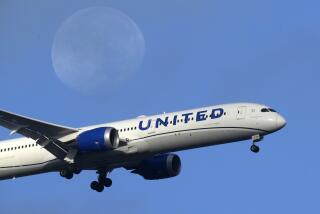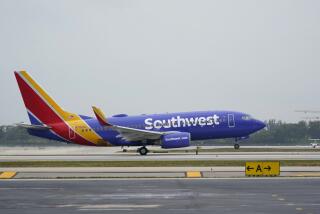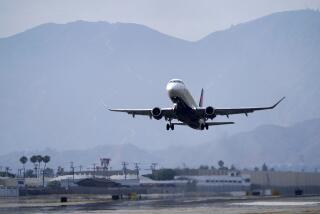U.S. Orders New Runway Precautions at LAX : Safety: Federal directive takes into account the wider wingspan of jumbo jets, which may infringe on the airport’s taxiways.
A jumbo jet’s encounter with another plane at Los Angeles International Airport has prompted a federal directive designed to keep aircraft farther apart on the airport’s runways and taxiways.
Under the directive, planes are not allowed to land or take off on a runway if another aircraft is on an intersecting taxiway close to the runway.
The action is not related to the fatal collision last February in which an air traffic controller mistakenly cleared a jetliner to land on a runway where she already had stationed a commuter plane for takeoff.
Fred O’Donnell, a spokesman for the Federal Aviation Administration here, said the directive was issued Aug. 27 after the pilot of a Boeing 747-200 expressed concern that the wings of his giant plane extended well beyond the edges of the runway and onto a taxiway being used by another plane.
It is a concern that has cropped up periodically for years, ever since the new generation of wide-body jets began using LAX, which was laid out years ago when aircraft were smaller.
O’Donnell said the incident that led to the directive occurred on Aug. 12, after a Federal Express Boeing 727 cargo jet used a perpendicular taxiway to cross one of the airport’s south-side runways--25 Right--en route to a maintenance facility on the north side of the airport.
The 727 pilot had been cleared to continue, O’Donnell said, but for some reason he stopped his plane just short of another taxiway parallel to and about 230 feet north of the runway he had just crossed.
Because the 727 is about 150 feet long, its tail was approximately 80 feet from the edge of the runway.
Moments later, O’Donnell said, the pilot of an Air New Zealand Boeing 747-200 ready for takeoff looked down Runway 25 Right and saw the 727.
Realizing that his jumbo jet’s wings were about 46 feet wider than the runway--and thus would extend about 23 feet into the taxiway on which the 727 was stationed--the Air New Zealand pilot asked air traffic control whether the 727 was clear of the runway.
Air traffic control assured him that it was, and the 747 accelerated down the runway. Air New Zealand said the jumbo jet lifted off well before it reached the taxiway where the 727 was stationed, and there was no danger of a collision.
But the 747 pilot later expressed concern that had he taxied longer, his wingtip might have passed within 57 feet of the tail of the 727. Officials noted that had the 747 not gone straight down the runway center line, and had the 727 not been pulled to the far end of the taxiway, the encounter could have been even closer than that.
The new FAA directive states that controllers should not clear a plane to land or take off on any runway if another plane is stationed between that runway and a parallel taxiway. The directive does not apply to planes stationed between parallel runways.
More to Read
Sign up for Essential California
The most important California stories and recommendations in your inbox every morning.
You may occasionally receive promotional content from the Los Angeles Times.










